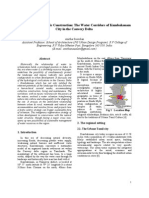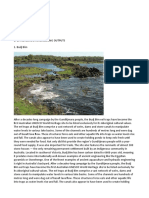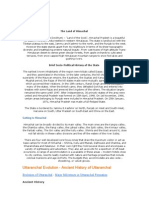Hampi
Hampi
Uploaded by
MohanCopyright:
Available Formats
Hampi
Hampi
Uploaded by
MohanOriginal Description:
Original Title
Copyright
Available Formats
Share this document
Did you find this document useful?
Is this content inappropriate?
Copyright:
Available Formats
Hampi
Hampi
Uploaded by
MohanCopyright:
Available Formats
HAMPI Hampi ( a.k.a Humpi or Hampe ) is both a historic & religious place in India.
This was the capital of the Hindu empire, Vijayanagara, who ruled the south India during 14th to 16th century AD. Hampi is located in Karnataka state , a southwestern province of India. Its about 350 kilometers (217 miles) north of Bangalore, the state capital. The ruins of Hampi, as it is known today, is a vast open museum of history, architecture and religion. Spread over an area more than 25 sq.km (10 sq. miles), Hampi ruins is packed with giant temples, palaces, market streets, aquatic structures , fortifications and an abundance of other ancient monuments.
The natural landscape The array of huge granite boulders rounded and seemingly detached from one another are haphazardly arranged to give unending hues of pink, ochre and grey in a landscape that is the result of some three thousand million years of erosion. The wind and rain has continuously swept away the soft soil, exposing the hard rocky outcrops. In fact, Hampi has one of the oldest surfaces one can see on earth. Due to the elements, and the fault lines on these rocky surfaces, cracks formed and the never-ending boulder formation started. The natural erosion polished boulders into bizarre shapes. Unlike how pebbles are polished in the flowing water of a river, Hampis boulders were formed by blowing wind. The strongly blowing sandy wind was something like rubbing a hard surface with sandpaper. This continued for many thousands of years, crafting the landscape of Hampi.
The Tungabhadra River flowing north-easterly adds its own dimension to this landscape.. Its valley is rich in boulders and scattered with lagoons, islands and smaller pools of water. Large tracts under banana and coconut plantations add manmade texture to the landscape. Cascades and rapids in the upper reaches versus continuous flooding and a gentler course in the lower areas make this river an inseparable element of the natural landscape of Hampi. Mythological landscape According to mythology, Hampi is the setting of some parts of Ramayana, the Hindu epic poem. The place was a monkey kingdom. Two monkey brothers, Vali and Sugreeva , were at war over the throne of the kingdom. The boulders strewn all over Hampi is what they threw at each other during the battles. Besides the legendary associations, the historic value of the site is further reinforced by the presence of prehistoric rock shelters that thrive in this region and evidence of Megalithic burial chambers a few kilometres west of the settlement of Anegondi Hydraulic works The great majority of the water features is inside the walled area of the Royal Centre. The Royal centre was provided with an elaborate water supply system, which exploited the principles of gravity flow and the siphon to convey relatively small quantities of water by pipeline and open channel. The kamalapura tank, with a backup system of wells. And rain water collection tanks, mainly supplied the system. The destination of supply taken into the royal centre was a complex series of baths , tanks, and fountains. The greatest concentration of these features was in and around the south east walled enclosure and area associated with the
performance and demonstration of royal ritual powers. The water features of the south east enclosure of the royal centre contain the Stepped Tank. This feature, which measures 22sq.m and some 7m deep, is fashioned entirely of finely finished, chlorite schist slabs arranged in a symmetrical formation, with steps and landings descending to the water on four sides. This design shows strong affinities with geometric temple tanks of the late Chalukya and Hoysala period found at other sites at Karnataka. On the basis of the kannada inscriptions carved into the slabs it is said that the chlorite schist blocks forming the tank were brought from elsewhere an re-assembled in site. The conservation of the rainfall and recycling of domestic water was undoubtedly an important factor. Small plastered conduits, which run around some of the structures of the royal centre, appear to have conserved rainwater; well preserved storage tanks are also scattered throughout the zone. The use of siphon and gravity flow enabled water to be fed in to fountains and basin at different levels. The best example of the siphon use at the Royal Centre is the pipe inlet near the Octagonal Fountain. This forms the west side of the large control tank feeding at least 6 separate pipelines. The purpose of this feature seems to have been to prevent silt from entering the sealed pipelines. Sculptures: Among the innumerable sculptures carved onto rocks and boulders scattered all over the Vijayanagara site , are memorial stones commemorating death by some heroic action. Four main types of memorial stones can be distinguished; the sati-stone (satikal), sati-cumhero- stone (sati-virakal), hero-stone (veerakal) and suicide memorial. The sun and the crescent moon that often appear the top of the memorial indicate the lasting glory of the sati or hero.
Boundaries and Feature of The Temple District Of Vitthalapura: The district of Vitthalapura is clearly defined geographically. The Thungabhadra river flows in a north-easterly direction approximately 100mt west of the Vitthala temple. Boulder y granite ridges constraint the district to the north and south. A two storied pavilion like gateway on the path running beside Thugabhadra from Hampi marks the southern entrance to the district. Another gopura style gateway is found to the north. As for the eastern extremity of the Vitthalapura this is represented by the ornate utsava (festival) mandapa at the end of the long colonnade street that runs eastward from the Vitthala temple.
You might also like
- Gipsy Cards - Zigeuner Wahrsagekarten MeaningsDocument4 pagesGipsy Cards - Zigeuner Wahrsagekarten MeaningsJozefa Seaqueen90% (21)
- Walking in The RainDocument6 pagesWalking in The RainSaoirse Lee100% (2)
- Chilka LakeDocument20 pagesChilka LakeJai Shree GaneshNo ratings yet
- Dal Lake FinalDocument26 pagesDal Lake FinalMuzamil RatherNo ratings yet
- NetflixDocument22 pagesNetflixdontcareNo ratings yet
- HAMPIDocument16 pagesHAMPIChanchal Soni100% (1)
- Aesthetics of Hindu TemplesDocument27 pagesAesthetics of Hindu TemplesUday DokrasNo ratings yet
- Karnataka N C CDocument25 pagesKarnataka N C CMadhusudana p nNo ratings yet
- Rock CutDocument104 pagesRock CutMeghna TripathiNo ratings yet
- Hampi - The Lost CityDocument94 pagesHampi - The Lost CityMeghna jNo ratings yet
- Manga HitiDocument22 pagesManga HitiSabita GuragainNo ratings yet
- Why Angkor Temples of Hindus Are Built On River Banks or Near RiversDocument26 pagesWhy Angkor Temples of Hindus Are Built On River Banks or Near RiversUday DokrasNo ratings yet
- Kaveri RiverDocument14 pagesKaveri RiverLokesh BangaloreNo ratings yet
- Evolution of Wein ResearchDocument2 pagesEvolution of Wein Researchatulraj8432No ratings yet
- Aestheitics of Shrestapura, LaosDocument9 pagesAestheitics of Shrestapura, LaosUday DokrasNo ratings yet
- 40 Socio CholaDocument3 pages40 Socio CholaVignesh Raj KNo ratings yet
- Presentation NepalDocument17 pagesPresentation Nepalaro8100% (1)
- 1/the Sundarbans Reserve ForestDocument6 pages1/the Sundarbans Reserve ForestAmalendu Sundar MandalNo ratings yet
- HAMPIDocument13 pagesHAMPIJoseph Kurian Mullasseril50% (2)
- Architectural Conservation: AssignmentDocument11 pagesArchitectural Conservation: AssignmentNEFSYA KAMALNo ratings yet
- Lec 11 Selective Archeological Sources (Primary) Mainamati, Gaud-LakhnautiDocument22 pagesLec 11 Selective Archeological Sources (Primary) Mainamati, Gaud-LakhnautiILHAMNo ratings yet
- DHOLAVIRADocument5 pagesDHOLAVIRAuday aggarwalNo ratings yet
- 1000 Shivlingas of India and CambodiaDocument7 pages1000 Shivlingas of India and CambodiaudayNo ratings yet
- Methods of Water ConservationDocument25 pagesMethods of Water ConservationNamita De100% (1)
- Hampi - Pride of The Vijayanagara EmpireDocument17 pagesHampi - Pride of The Vijayanagara EmpireRiyanshi RaoNo ratings yet
- The DeccanDocument27 pagesThe DeccanJBR ARCHITECTURE GROUPSNo ratings yet
- Hampi: Submitted By: Mehakdeep B.A.LL.B. (HONS.) 2 Semester ROLL NO. 183/22Document14 pagesHampi: Submitted By: Mehakdeep B.A.LL.B. (HONS.) 2 Semester ROLL NO. 183/22Mehak DeepNo ratings yet
- Anitha Lake2008 Full PaperDocument7 pagesAnitha Lake2008 Full PaperAnitha Suseelan100% (1)
- Mainamati BanglapediaDocument7 pagesMainamati BanglapediaShafiq RehmanNo ratings yet
- Kashmir-A Forgotten Paradise!Document113 pagesKashmir-A Forgotten Paradise!muqbil lateefNo ratings yet
- Chennai LakesDocument13 pagesChennai Lakessrinihema1961No ratings yet
- Bellary 1972 Chapter19 Places of Interest PDFDocument34 pagesBellary 1972 Chapter19 Places of Interest PDFDeepak PrasadNo ratings yet
- The River of CauveryDocument4 pagesThe River of CauveryJeganNo ratings yet
- Hampi: by Tamarapu Sampath KumaranDocument9 pagesHampi: by Tamarapu Sampath KumaranT Sampath KumaranNo ratings yet
- Drainage System and WatershedDocument13 pagesDrainage System and Watershedamanamu436No ratings yet
- HAMPIDocument1 pageHAMPICharu GargNo ratings yet
- Evs ProjectDocument14 pagesEvs ProjectRohit MishraNo ratings yet
- Dhola ViraDocument6 pagesDhola ViraayandasmtsNo ratings yet
- Lecture 3 Indus Valley CivilizationDocument16 pagesLecture 3 Indus Valley CivilizationNihal Singh VermaNo ratings yet
- History ProjectDocument11 pagesHistory ProjectAditi KarnwalNo ratings yet
- Yodha ElaDocument1 pageYodha ElaPanduka NeluwalaNo ratings yet
- The Splendours of Hampi & The Vijayanagara Empire (A photographic journey for young historians aged 7-70)From EverandThe Splendours of Hampi & The Vijayanagara Empire (A photographic journey for young historians aged 7-70)No ratings yet
- Sacred Springs of JammuDocument15 pagesSacred Springs of JammuLalit GuptaNo ratings yet
- Mahaba Lip Ur AmDocument17 pagesMahaba Lip Ur AmAnonymous XmHYQzlYLYNo ratings yet
- Indigenous EngineeringDocument15 pagesIndigenous EngineeringFaithElle LabtuonNo ratings yet
- Gateway of India: Victoria and Albert Museum DR Bhau Daji Lad MuseumDocument3 pagesGateway of India: Victoria and Albert Museum DR Bhau Daji Lad MuseumPooja JhaveriNo ratings yet
- Historical Monuments of Karnataka: Bhumika Purohit Ix-BDocument12 pagesHistorical Monuments of Karnataka: Bhumika Purohit Ix-BAditya Dhuria100% (1)
- Landscapes and Ramayana LegendDocument11 pagesLandscapes and Ramayana LegendMayank Dixit100% (1)
- Geology of Salt RangeDocument18 pagesGeology of Salt RangeAdil KhanNo ratings yet
- An Imperial Capital Vijayanagara: Srijan SrivastavaDocument13 pagesAn Imperial Capital Vijayanagara: Srijan Srivastavasudhir srivastavaNo ratings yet
- HampiDocument3 pagesHampisraymukherjeeNo ratings yet
- Drainage System: Drainage Systems of IndiaDocument7 pagesDrainage System: Drainage Systems of IndiaAbhinavNo ratings yet
- Drainage System IghjjjDocument8 pagesDrainage System IghjjjAkhilesh YadavNo ratings yet
- 6.history and Culture of Assam and The BrahmaputraDocument31 pages6.history and Culture of Assam and The BrahmaputraJoinal Hussain TapadarNo ratings yet
- Mr.P.P.hettiarachchi - SigiriyaDocument7 pagesMr.P.P.hettiarachchi - SigiriyaDilhaniNo ratings yet
- Longhurst The Great Stupa at Nagarjunakonda in Southern India.Document10 pagesLonghurst The Great Stupa at Nagarjunakonda in Southern India.Roberto E. GarcíaNo ratings yet
- About HimachalDocument3 pagesAbout HimachalgurpreetjhunirNo ratings yet
- Salt RangeDocument3 pagesSalt RangeWaqas NizamiNo ratings yet
- AGRADocument36 pagesAGRAdhananjai1No ratings yet
- Rock Carvings in Usgalimal. An OverviewDocument17 pagesRock Carvings in Usgalimal. An OverviewSimon VotteroNo ratings yet
- GandhiDocument40 pagesGandhiMohanNo ratings yet
- Generalife GardensDocument7 pagesGeneralife GardensMohanNo ratings yet
- Garrett EckboDocument5 pagesGarrett EckboMohan100% (2)
- Human Rights and MediaDocument19 pagesHuman Rights and MediaMohanNo ratings yet
- MMJAA Chhibramau Rural-UrbanDocument12 pagesMMJAA Chhibramau Rural-UrbanAmit SinghNo ratings yet
- Personal Information QuestionsDocument1 pagePersonal Information QuestionsJose Armando Romero50% (2)
- OpticsDocument84 pagesOpticsNoorzad Khalqi0% (1)
- Answers To There Will Come Soft Rains TEXT DEPENDENT QSDocument5 pagesAnswers To There Will Come Soft Rains TEXT DEPENDENT QSkimoraNo ratings yet
- Bad Boys BlueDocument3 pagesBad Boys BlueFlorencia LaymehNo ratings yet
- Art of Versification / R. F. BrewerDocument398 pagesArt of Versification / R. F. BrewerPhillip A Ellis100% (1)
- Ebook Novel Dewasa GratisDocument2 pagesEbook Novel Dewasa GratisWulAn KùcrietNo ratings yet
- 3h5jv RDocument84 pages3h5jv RAlvaro Madrid100% (1)
- BBA English Lecture 4 Solution PDFDocument6 pagesBBA English Lecture 4 Solution PDFsabidNo ratings yet
- AAFT 98 Batch Fees Structure: Fee Break Up For 3 Installment PlanDocument1 pageAAFT 98 Batch Fees Structure: Fee Break Up For 3 Installment PlanPradeep KewatNo ratings yet
- Future FormsDocument8 pagesFuture FormsAlaNo ratings yet
- The Chuvannathadi in Kathakali An Evaluation of The Character Type VeshamDocument5 pagesThe Chuvannathadi in Kathakali An Evaluation of The Character Type VeshamEditor IJTSRDNo ratings yet
- Prophetic Supplications (Arabic/English)Document69 pagesProphetic Supplications (Arabic/English)Dar Haqq (Ahl'al-Sunnah Wa'l-Jama'ah)100% (1)
- Ce Correl Plane GeometryDocument2 pagesCe Correl Plane GeometryGlenn Frey LayugNo ratings yet
- Borang Standard Prestasi Bahasa Inggeris Tahun 3Document2 pagesBorang Standard Prestasi Bahasa Inggeris Tahun 3Mimie Norhidayati100% (1)
- Pachelbel's Christmas PreludeDocument5 pagesPachelbel's Christmas PreludeJoy NiloNo ratings yet
- An Introduction To 3D ScanningDocument29 pagesAn Introduction To 3D ScanninggouluNo ratings yet
- Morphophonemic Rules: Turdalieva Daria HL 2-19 ADocument8 pagesMorphophonemic Rules: Turdalieva Daria HL 2-19 ADaria TurdalievaNo ratings yet
- Best Out of WasteDocument62 pagesBest Out of WasteVishal KatiyarNo ratings yet
- Felix Guenther - Piano Duets For ChildrenDocument192 pagesFelix Guenther - Piano Duets For Childrenjoanaoliveira8100% (5)
- Michaels 5Document2 pagesMichaels 5Jim WestNo ratings yet
- Teralux TLE300Document1 pageTeralux TLE300vasttracts3844No ratings yet
- Barnabas Ki Injeel PDFDocument10 pagesBarnabas Ki Injeel PDFMudassar MeerNo ratings yet
- Riddles About Parts of BodyDocument5 pagesRiddles About Parts of BodyDio Nia100% (1)
- Jaidev Miglani - Hamlet Animal Comparison - 11100437Document2 pagesJaidev Miglani - Hamlet Animal Comparison - 11100437api-551273657No ratings yet
- Eksternal November 2018Document436 pagesEksternal November 2018Gamer Maniac0% (1)
- Ashadowonfallenblossoms Exc PDFDocument18 pagesAshadowonfallenblossoms Exc PDFlist_courseNo ratings yet





























































































